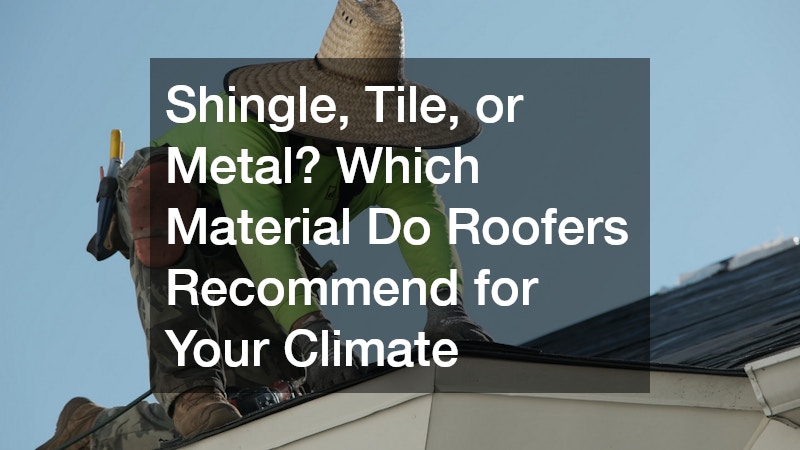
Shingle, Tile, or Metal? Which Material Do Roofers Recommend for Your Climate
Choosing the right roofing material is crucial for ensuring the longevity and effectiveness of your roof, especially given the wide variety of climate conditions across different regions. Roofers often tailor their recommendations based on local climate factors such as temperature variations, precipitation levels, and storm frequency. An informed decision not only safeguards your home but also maximizes the value and efficiency of your investment in roofing materials.
How Does Climate Affect Roofing Material Recommendations?
Different climate zones, including tropical, arid, and temperate regions, have unique demands when it comes to roofing materials. For instance, tropical areas often require materials that can withstand high humidity and intense rainfall, whereas arid zones benefit from materials that reflect heat. As a result, roofers take these regional climate characteristics into account to recommend materials that will perform optimally under specific environmental stresses.
Temperature is a significant driver of roofing material selection, with each zone presenting distinct challenges and requirements. In tropical climates, where rain is frequent and heavy, roofing must be resistant to water absorption and damage. Conversely, arid climates require roofing that can reflect the sun’s heat, maintaining indoor comfort and reducing energy costs.
Understanding climate zones plays a critical role in roofing because it influences not only the choice of materials but also the design and installation methods. By recognizing the environmental conditions of a specific area, roofers can recommend the most durable and cost-effective solutions. Furthermore, the selection process is guided by the goal of achieving energy efficiency and maintaining structural integrity over time.
Temperature fluctuations can dramatically impact the performance and lifespan of roofing materials. Materials that might contract and expand significantly due to temperature changes can develop cracks or lose their structural integrity over time. Roofers often suggest materials like metal that can withstand such fluctuations without compromising on performance.
What Are the Pros and Cons of Shingle, Tile, and Metal Roofing?
Shingle roofing is popular for its affordability and ease of installation, making it an attractive option for homeowners on a budget. However, shingle roofs tend to have a shorter lifespan compared to other materials, with vulnerabilities exposed during severe weather conditions such as heavy winds and hail. Despite these challenges, shingles are often chosen for their versatility and aesthetic variety.
One key advantage of shingles is their ease of repair and replacement, allowing homeowners to manage maintenance without excessive cost. Yet, the maintenance needs can be more frequent due to damage from UV radiation and weathering. This results in shingles being potentially more costly over the long term, as regular inspections and minor repairs become necessary.
In terms of energy efficiency, shingle roofs typically offer less insulation, which can lead to higher energy bills in extreme climates. On a positive note, many modern shingles offer improved reflectivity and impact resistance, providing options that perform better in challenging environments. Thus, the choice of shingle roofing should be carefully weighed against the specific climate and performance requirements of the homeowner.
How Do Cost and Maintenance Compare Across These Materials?
The initial cost of roofing materials varies significantly, with shingles generally being the least expensive upfront. Tile roofs often come with a higher price tag due to their material and installation requirements, while metal roofs can vary widely in cost based on design and material type. Long-term costs can be more challenging to account for, as they depend heavily on maintenance needs and potential for repairs over time.
While shingles may be cheaper initially, their shorter lifespan and higher repair frequency can lead to increased cumulative expenses over the years. Tile and metal roofs, though more costly to install, often result in lower maintenance costs and longer lifespans, providing more value. These long-term investments can also translate into improved energy efficiency, further balancing out initial expenditures.
Investment in roofing should consider both the upfront cost and the long-term financial benefits and savings it provides. Homeowners are advised to evaluate the environmental conditions that could trigger frequent repairs, impacting the overall cost efficiency of their chosen material. By anticipating these factors, one can make a more informed decision that aligns with both financial capacity and climate demands.
Maintenance requirements for roofing materials can differ dramatically, influencing the overall effort and cost involved in preserving their condition. Shingle roofs typically demand more frequent inspections and minor repairs, especially in climates with high wind or UV exposure. In contrast, metal roofs demand less frequent upkeep but can require specialized knowledge for occasional repairs.
Understanding the climate-specific needs and the characteristics of shingle, tile, and metal roofing is key to making an informed decision. Each material has its unique set of benefits and challenges, which must be weighed against the environmental conditions, budget constraints, and long-term goals of the homeowner. By carefully evaluating these factors, homeowners can select the most appropriate roofing solution to ensure durability, cost efficiency, and comfort for their specific living environment.


